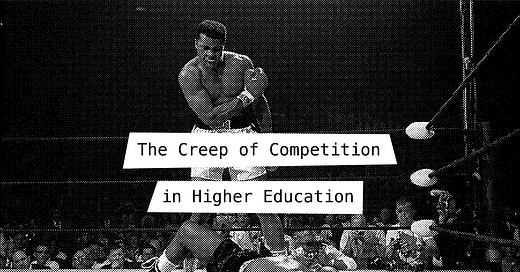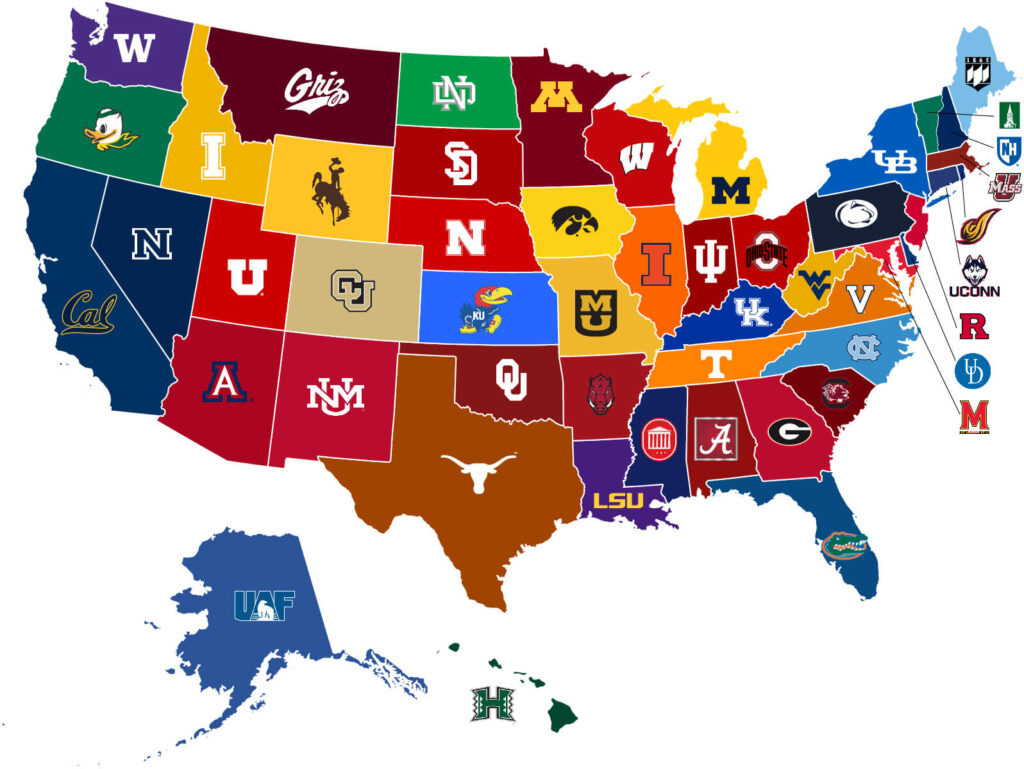The Creep of Competition in Higher Education
The underlying truth about American higher education is that the system incentivizes competition, and in such a system, every school is becoming tuition-driven.
The Market is Really Hard
The enrollment crisis facing hundreds of colleges and universities is rooted in a higher education system strategically designed to create competition. (This strategic design was explained in Part 1 and Part 2 of “When Universities Need More Money”). From feeling the need to “keep up with the Joneses” to fighting for survival amid “constant threats,” the language used by school leaders conveys the intense competitive pressures they face in an enrollment market where “everybody is going after the same kid.”
For the tuition-driven sector, this is nothing new, but as reported last week in the Wall Street Journal, more schools are now waking up to this reality. The situation was summed up simply by one admissions leader I interviewed for Capitalizing on College: “This is a competition, and the market is really hard.”
Without the security blanket of their elite counterparts’ sizable endowments, tuition-driven schools have long acknowledged the competition that drives American higher ed and strategized to compete for students in order to keep their doors open and secure the all-important federal “per student” funding. To stave off other institutions, their leaders constantly create new enrollment markets and educational products—a “new realm with badgification and gamification and nanodegrees,” as one senior leader ruefully observed. As one administrator told me, “If we are doing three years from now what we were doing three years ago, we’re old news.”
This reality is stark: “When you’re a tuition-driven school,” one administrator told me, “keeping students coming is always a challenge, and there’s considerable anxiety when the student count goes down.” The pressures of this system led to an era of unprecedented expansion across the American higher education landscape, characterized by overburdened administrators desperately “trying to be creative and innovative in the offering of programs that are applicable to a changing world.”
These leaders have also watched this competition grow unfettered in the last several decades, with one provost observing, “It’s just so much more competitive and so much more market driven.” It was no surprise then when administrators said they noticed a new competitor had recently begun to creep into their enrollment market. As one senior leader told me,
One day last spring, I remember sitting here laughing because all of a sudden within a two-week time period I personally had been approached by Penn State, Ohio State, [tapping his temple], I want to say Georgia State and Florida. All these major schools were contacting me about something and wanting to know what we were doing… They were looking and asking, “What’s going on over there? They’ve been successful with it. Let’s figure out what they’re doing.”
Everyone is Becoming Tuition-Driven
For many years, public universities had not felt the same competitive pressures that most tuition-driven institutions face as their budgets were more insulated from the effects of fluctuating enrollment due to state funding. However, as a recent article in the Wall Street Journal highlights, the pressure of competition is no longer solely contained to the tuition-driven sector but has even caught up to public universities, pitting “flagship” schools against other institutions.
In a battle of haves vs. have-nots that is all too familiar to tuition-driven schools, the article describes how “large flagship universities––blessed with strong academic reputations and high-profile sports programs” have managed to thrive in the increasingly challenging higher education marketplace by increasing the size of their student body to secure more “per student” funding. At these bigger public four-year schools, the Journal found that enrollment increased 9% in 2023 compared to 2015. “Flagship” schools like the University of Tennessee-Knoxville and the University of Illinois at Urbana-Champaign recently experienced more than 30% growth in their respective enrollments.
The article goes on to explain how the detrimental effects of enrollment competition compound across sectors. “It starts to accumulate in smaller college towns, especially for colleges that don’t have billions of dollars in the bank,” according to Andrew Koricich, executive director of the Alliance for Research on Regional Colleges. Enrollment is down even at less prominent regional state schools. But nowhere has the recent competition been more pronounced than at tuition-driven schools, dramatically affecting the financial dynamics of many.
Crossing the Line
Tuition-driven administrators were not slow to recognize these schools as direct threats to their bottom-line, forcing them to work even harder to remain at the forefront of the market. But more often than not, the creep of competition incentivized leaders at these schools to “push the limits” when it came to securing enrollment growth, putting them on a path they described as going over “to the dark side.” Recognizing the importance of institutional introspection, one senior leader in a tone of regret candidly described the extent to which her school’s decision-making had bent to the pressure of competition:
Years ago one of our former general counsels said, ‘You do realize you just crossed this line in the sand?’ I thought to myself, ‘Gosh, he may be right here’… we had pushed it right to the edge, but it took him pointing it out to me that maybe we went over the line this time.
What were these line-crossing deeds? A vice president at one school explained a worrisome practice involving finances and maximizing enrollment that posed a value risk: “To use an ugly phrase, it’s kind of like the bait and switch. You come to our school, we give you a good financial aid package up front for year one… they aren’t necessarily going to be successful students, but they can borrow.” The administrator continued in a lower voice:
Year two rolls around. Because they’re not [the] top tier students… they don’t get those academic scholarships, and so now they need loans. Students who are borrowing money to go to school, and not necessarily going to be successful… that’s another way to really boost your net revenue.
At another school that was Catholic in affiliation, the leadership shifted financial strategies to extract more money from each student in order to maintain a competitive edge in the market. An administrator there believed that the decision blatantly crossed the line: “To me it’s kind of a gluttony question. It’s so not Catholic. It’s like so sinful.”
Over and over again I heard administrators admitting that the competitiveness of higher education in America forced them to constantly reevaluate their mission – and whether they needed to stretch its boundaries and limits in order to survive.
One tuition-driven school I visited plunged headfirst into the competition pool. Drawing on data practices from Fortune 500 companies, they leveraged operational analytics to generate new degrees for the workforce of the future. But they didn’t stop there: as competition increased, executives at this school took clandestine steps to poach students and data from their competitors. In a remarkable understatement, the school’s president said, “I would say we are probably more aggressive than most schools.”
No Smoke-Filled Rooms
As the entirety of the American higher education industry becomes saturated by competition, there are a dwindling number of schools that can afford to ignore the nature of the system in which they exist. One vice president admitted feeling relief when their institution’s values were unexpectedly rewarded by policy decisions designed to foster competition: “We don’t want to be market driven, but it is great when the marketplace and our mission come together.”
But more often than not, a system built for competition makes unwitting brokers out of school administrators who are simply using the tools at their disposal to innovate in incentivized ways. Recognizing the tension of running a university within such a system, a senior leader I interviewed poignantly acknowledged how a school’s mission can become unintentionally twisted on the path to growth. “This is just not what we’re about… I don’t think people sat around in a smoke-filled room and hatched this plot. I think it’s just our penchant for growth that resulted in this.”
As more schools begin to feel the full weight of this market system and both external and internal consequences materialize, we are left to assess the costs and wonder whether any boundaries remain. The big question now facing American college and university leaders is not whether they will have to grapple with growing competition, but rather what survival looks like now that it’s at their doorstep.
Extra Edge:
Issue Soundtrack: The Boxer by Mumford and Sons (Simon & Garfunkel Cover)
Present HigherEd Crisis: I was hosted by the Future Trends Forum with Bryan Alexander last week to discuss the present crisis in higher education. A full recording of the podcast is available on YouTube.
Additional Reading: If you’re looking to dig even deeper into the topic of higher education and the conversations surrounding it, check out this collection of some of my past publications.
Restocked and Ready: After selling out on Amazon twice in the past month, my book, Capitalizing on College: How Higher Education Went From Mission Driven to Margin Obsessed, has been restocked! If you haven’t had a chance yet, be sure to grab your copy now using this link!
How to Support: The Leading Edge newsletter is sent out twice monthly. You can help keep it coming by purchasing a copy of Capitalizing on College, forwarding this email to a friend, or simply clicking the "like" button below. Please drop me a note on Substack, LinkedIn, X, or my website - I would love to hear from you.







This is why despite all of us in higher ed criticizing the rankings, we are sort of forced to acquiesce to their power. Stuck.